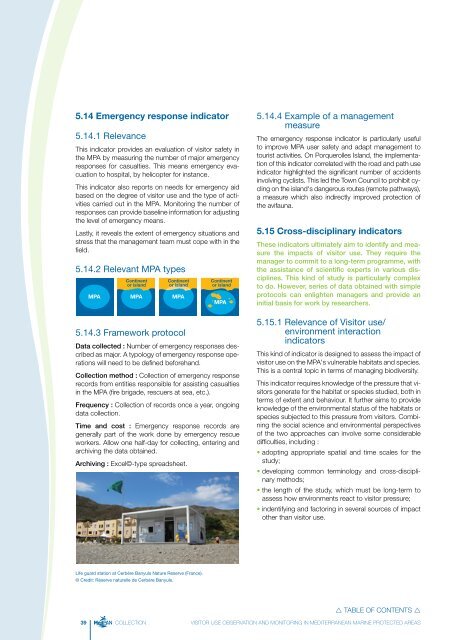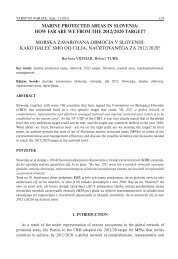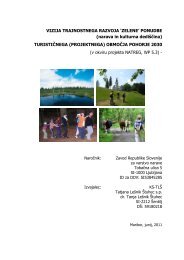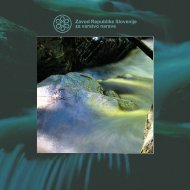Monitoring MPA visitor uses handbook
Monitoring MPA visitor uses handbook
Monitoring MPA visitor uses handbook
- No tags were found...
Create successful ePaper yourself
Turn your PDF publications into a flip-book with our unique Google optimized e-Paper software.
5.14 Emergency response indicator5.14.1 RelevanceThis indicator provides an evaluation of <strong>visitor</strong> safety inthe <strong>MPA</strong> by measuring the number of major emergencyresponses for casualties. This means emergency evacuationto hospital, by helicopter for instance.This indicator also reports on needs for emergency aidbased on the degree of <strong>visitor</strong> use and the type of activitiescarried out in the <strong>MPA</strong>. <strong>Monitoring</strong> the number ofresponses can provide baseline information for adjustingthe level of emergency means.Lastly, it reveals the extent of emergency situations andstress that the management team must cope with in thefield.5.14.2 Relevant <strong>MPA</strong> types<strong>MPA</strong>Continentor island<strong>MPA</strong>Continentor island<strong>MPA</strong>5.14.3 Framework protocolContinentor island<strong>MPA</strong>Data collected : Number of emergency responses describedas major. A typology of emergency response operationswill need to be defined beforehand.Collection method : Collection of emergency responserecords from entities responsible for assisting casualtiesin the <strong>MPA</strong> (fire brigade, rescuers at sea, etc.).Frequency : Collection of records once a year, ongoingdata collection.Time and cost : Emergency response records aregenerally part of the work done by emergency rescueworkers. Allow one half-day for collecting, entering andarchiving the data obtained.Archiving : Excel©-type spreadsheet.5.14.4 Example of a managementmeasureThe emergency response indicator is particularly usefulto improve <strong>MPA</strong> user safety and adapt management totourist activities. On Porquerolles Island, the implementationof this indicator correlated with the road and path useindicator highlighted the significant number of accidentsinvolving cyclists. This led the Town Council to prohibit cyclingon the island's dangerous routes (remote pathways),a measure which also indirectly improved protection ofthe avifauna.5.15 Cross-disciplinary indicatorsThese indicators ultimately aim to identify and measurethe impacts of <strong>visitor</strong> use. They require themanager to commit to a long-term programme, withthe assistance of scientific experts in various disciplines.This kind of study is particularly complexto do. However, series of data obtained with simpleprotocols can enlighten managers and provide aninitial basis for work by researchers.5.15.1 Relevance of Visitor use/environment interactionindicatorsThis kind of indicator is designed to assess the impact of<strong>visitor</strong> use on the <strong>MPA</strong>'s vulnerable habitats and species.This is a central topic in terms of managing biodiversity.This indicator requires knowledge of the pressure that <strong>visitor</strong>sgenerate for the habitat or species studied, both interms of extent and behaviour. It further aims to provideknowledge of the environmental status of the habitats orspecies subjected to this pressure from <strong>visitor</strong>s. Combiningthe social science and environmental perspectivesof the two approaches can involve some considerabledifficulties, including :• adopting appropriate spatial and time scales for thestudy;• developing common terminology and cross-disciplinarymethods;• the length of the study, which must be long-term toassess how environments react to <strong>visitor</strong> pressure;• indentifying and factoring in several sources of impactother than <strong>visitor</strong> use.Life guard station at Cerbère Banyuls Nature Reserve (France).© Credit: Réserve naturelle de Cerbère Banyuls. TABLE OF CONTENTS 39 COLLECTION VISITOR USE OBSERVATION AND MONITORING IN MEDITERRANEAN MARINE PROTECTED AREAS
















